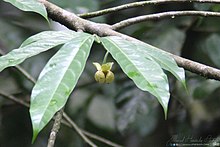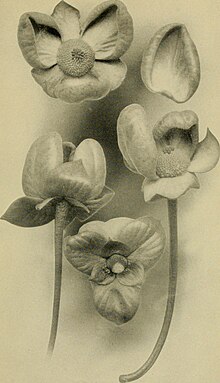
The Annonaceae are a family of flowering plants consisting of trees, shrubs, or rarely lianas commonly known as the custard apple family or soursop family. With 108 accepted genera and about 2400 known species, it is the largest family in the Magnoliales. Several genera produce edible fruit, most notably Annona, Anonidium, Asimina, Rollinia, and Uvaria. Its type genus is Annona. The family is concentrated in the tropics, with few species found in temperate regions. About 900 species are Neotropical, 450 are Afrotropical, and the remaining are Indomalayan.

Monodora myristica, the calabash nutmeg, is a tropical tree of the family Annonaceae or custard apple family of flowering plants. It is native to Angola, Benin, Cameroon, the Central African Republic, the Democratic Republic of the Congo, Equatorial Guinea, Gabon, Ghana, Guinea-Bissau, Ivory Coast, Kenya, Liberia, Nigeria, the Republic of the Congo, Sierra Leone, Sudan, Tanzania, Togo and Uganda. In former times, its seeds were widely sold as an inexpensive nutmeg substitute. This is now less common outside its region of production. Other names of calabash nutmeg include Jamaican nutmeg, African nutmeg, ehuru, ariwo, awerewa, ehiri, airama, African orchid nutmeg, muscadier de Calabash and lubushi.
Mitrephora fragrans is a species of plant in the family Annonaceae. It is native to Borneo and The Philippines. Elmer Drew Merrill, the American botanist who first formally described the species, named it after its large, fragrant flowers.

Cymbopetalum is a genus of plant in family Annonaceae. The Linnean name derives from the Latin cymba, meaning “boat,” and petalum, meaning "petal.”
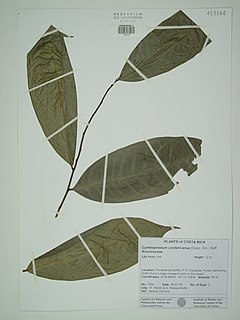
Cymbopetalum costaricense is a species of plant in the family Annonaceae. The specific epithet refers to the country of Costa Rica which is in the plant's range. It grows as a tree.

Annona macroprophyllata is a species of plant in the family Annonaceae. It is native to El Salvador, Guatemala, Honduras and Mexico. John Donnell Smith, the American botanist who first formally described the species, named it after its large leaves.

Goniothalamus giganteus is a species of plant in the family Annonaceae. It is native to Malaya, Myanmar, Sumatra and Thailand. Joseph Dalton Hooker and Thomas Thomson, the British botanists who first formally described the species, named it after its exceptionally large flowers.
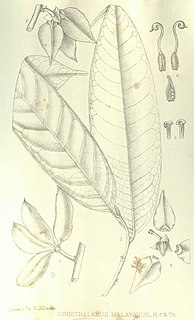
Goniothalamus malayanus is a species of plant in the family Annonaceae. It is native to Borneo, the Malay Peninsula, the Nicobar Islands, Sumatra and Thailand. Joseph Dalton Hooker and Thomas Thomson, the British botanists who first formally described the species, named it after part of its habitat range, British Malaya.
Goniothalamus rotundisepalus is a species of plant in the family Annonaceae. It is native to Peninsular Malaysia and Thailand. Murray Ross Henderson, the Scottish botanist who first formally described the species, named it after its sepals which are rounded like the arc of a circle.
Monodora laurentii is a species of plant in the family Annonaceae. It is native to the Democratic Republic of the Congo, Gabon, and the Republic of the Congo. Émile De Wildeman, the Belgian botanist who first formally described the species, named it after Marcel Laurent, the Belgian botanist who collected many plant specimens in the regions along the Congo River.
Monodora minor is a species of plant in the family Annonaceae. It is native to Mozambique and Tanzania. Heinrich Gustav Adolf Engler and Ludwig Diels, the German botanists who first formally described the species, do not explicitly explain the specific epithet but it is among the smaller members of the genus which includes species that reach heights of 30-40 meters.
Pseudoxandra leiophylla is a species of plant in the family Annonaceae. It is native to Brazil, Colombia, and Venezuela. Ludwig Diels, the German botanist who first formally described the species using the basionym Unonopsis leiophylla, named it after its smooth leaves.
Pseudoxandra polyphleba is a species of plant in the family Annonaceae. It is native to Bolivia, Brazil, Colombia, French Guiana, Guyana, and Peru. Ludwig Diels, the German botanist who first formally described the species using the basionym Unonopsis polyphleba, named it after the distinctive veins in its leaves.
Pseuduvaria aurantiaca is a species of plant in the family Annonaceae. It is endemic to New Guinea. Friedrich Anton Wilhelm Miquel, the Dutch botanist who first formally described the species using the basionym Orophea aurantiaca, named it after its orange colored fruit.
Pseuduvaria lignocarpa is a species of plant in the family Annonaceae. It is native to New Guinea. James Sinclair, the Scottish botanist who first formally described the species, named it after the woody wall of its fruit.
Pseuduvaria mindorensis is a species of plant in the family Annonaceae. It is native to the Philippines. Yvonne Su and Richard Saunders, the botanists who first formally described the species, named it after the island of Mindoro where the specimen they examined was collected in the municipality of Puerto Galera.
Pseuduvaria pulchella is a species of plant in the family Annonaceae. It is native to New Guinea. Ludwig Diels, the botanist who first formally described the species using the basionym Orophea pulchella, chose a specific epithet that means “beautiful little” in Latin, but he did not specify to which aspect of the plant he was referring.
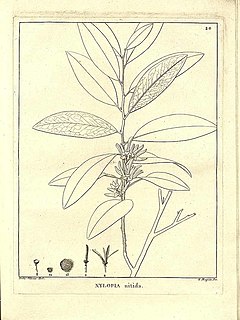
Xylopia nitida is a species of plant in the Annonaceae family. It is native to Brazil, Colombia, Ecuador French Guiana, Guyana, Suriname and Venezuela. Michel Félix Dunal, the botanist who first formally described the species, named it after the shiny upper surface of its leaves.
Xylopia calophylla is a species of plant in the Annonaceae family. It is native to Bolivia, Brazil, Colombia, Ecuador, Peru and Venezuela. Robert Elias Fries, the botanist who first formally described the species, named it after its beautiful leaves.
Xylopia polyantha is a species of plant in the Annonaceae family. It is native to Bolivia, Brazil, Colombia, Ecuador, and Peru. Robert Elias Fries, the botanist who first formally described the species, named it after its many flowers.
